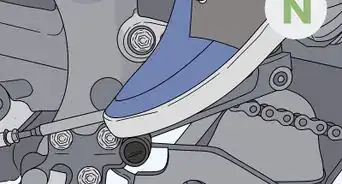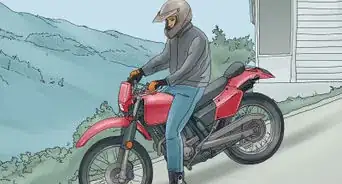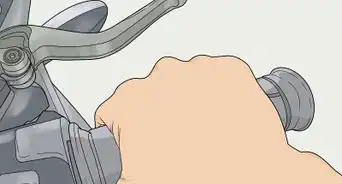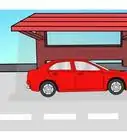This article was co-authored by wikiHow Staff. Our trained team of editors and researchers validate articles for accuracy and comprehensiveness. wikiHow's Content Management Team carefully monitors the work from our editorial staff to ensure that each article is backed by trusted research and meets our high quality standards.
This article has been viewed 90,842 times.
Learn more...
While motorcycles make for great transportation, you can’t always ride yours to wherever you may be going. If you choose to transport your motorcycle by truck or trailer, make sure to secure it properly using ratchet straps to prevent it from tipping over in transit. If you instead opt to pay a shipping company, make sure you understand the services they provide and what to do if your motorcycle is damaged along the way.
Steps
Loading a Motorcycle into a Pickup Truck
-
1Park the truck and motorcycle on a firm, level surface. Never attempt to load a motorcycle into a pickup truck on uneven ground, or soft ground that may give way as you move the motorcycle. Black top or concrete are the preferred surfaces to use when loading your bike into a pickup truck.[1]
- Never use pieces of wood on grass or dirt as a loading surface, as the wood may sink, break or slide.
- Do not attempt to load a motorcycle into a truck on an uneven surface to prevent falling over or dropping the motorcycle itself as you load it.
-
2Unfold the motorcycle ramp and place the rubber end on the tailgate. You should always use a ramp intended for use in loading motorcycles onto trucks and trailers when doing so. Motorcycles can be extremely heavy, so the ramp must be designed to be able withstand the weight of the motorcycle. These ramps usually fold in half to easily transport them, so unfold it and place the rubber end on the tailgate of the truck. The metal end should rest flat on the ground.[2]
- The rubber will protect the tailgate of the truck from being scratched as the truck’s suspension lowers under the weight of the motorcycle.
- Be sure the ramp rests evenly on the ground to ensure it does not damage your motorcycle tire or cause it to move in an unpredictable way when you’re pushing it onto the ramp.
Advertisement -
3Use a ratchet tie-down to secure the ramp to the truck. Most ramps will have a hook intended for use in securing the ramp to the truck. Place one hook from a ratchet tie down (also known as a ratchet strap) through the hook on the ramp and secure the other end to a loop or hook in the bed of the truck. Use the ratchet to tighten the strap until the ramp is held firmly in place.[3]
- Without a strap securing the ramp, it could slide backward and fall off the tailgate of the truck when you push the motorcycle onto it.
- Do not use a bungee strap to secure the ramp. Bungee straps may give, allowing the ramp to fall.
-
4Put the motorcycle in neutral. If you leave your motorcycle in gear to prevent the wheels from rolling when you aren’t riding it, you will need to take it back out of gear in order to push it. Motorcycle shift levers are located on the side of the motorcycle and are controlled by the rider’s left foot. Press down on the shift lever until the motorcycle is in first gear, the pull back up on the lever lightly to put it in neutral.[4]
- Neutral in a motorcycle is found between first and second gear.
- Most motorcycles have a neutral light on the gauge pod to let you know that the motorcycle is in neutral.
-
5Have a friend help push the motorcycle up the ramp. Pushing your motorcycle onto the truck should be a two person job. Attempting to do so alone could result in the motorcycle falling, causing significant harm to the bike and to you. Place both of your hands on the handle bars of the motorcycle and ask your friend to push from the back. Roll it up the ramp together, but stop before the motorcycle is all the way into the truck. Use your right hand to squeeze the front brake lever on the handle bars to prevent the motorcycle from rolling backwards as your friend climbs into the bed of the truck to help pull it the rest of the way.
- Having your friend switch places halfway through will not be necessary if you can enlist the help of a third friend.
- Make sure the brakes are holding the weight of the motorcycle from rolling backward before your friend releases it to climb into the truck.
Securing a Motorcycle to a Truck or Trailer
-
1Gather the necessary equipment. In order to securely strap your motorcycle in place on a trailer or in the bed of a pickup truck, you will need three ratchet straps with at least one “soft loop” or heavy duty loop for your straps that is designed to prevent damage from rubbing on painted components of your motorcycle. You may also choose to utilize a motorcycle wheel chock, but in many applications it is not required.[5]
- Make sure you have ratchet straps or tie downs to properly secure the motorcycle. Bungee chords will not suffice.
- Soft loops and ratchet straps can be purchased at many large retail stores, auto parts stores or motorcycle specialty stores.
-
2Place wheel chocks around the rear tire. If you opt to use wheel chocks, you should place one in front of and behind the rear wheel. As the motorcycle is transported, it may rock forward and backward, and the chocks will help prevent too much pressure from being placed on the ratchet straps.[6]
- Wheel chocks are recommended for heavier motorcycles such as cruisers and grand touring bikes.
- Some motorcycle wheel chocks are shaped like a “U” and are designed to hold the entire front or rear tire.
-
3Strap the handlebars to the sides of the truck or trailer. With the bike in position on the trailer or in the truck, hang two ratchet straps from the handle bars (one on each side). Secure the opposite end of each strap to a loop or hook on the trailer or truck that is further back than the handlebars so the straps hang at an angle from the front of the bike to the back of the truck or trailer. Tighten the straps enough until they are taut, but you will need to tighten them further once the back of the bike is strapped down as well.[7]
- The ratchet straps should be secured on either side of the truck or trailer to hooks that are further back than the handle bars.
- Optimally, the straps should be a forty-five degree angle from the motorcycle if viewed from above.
-
4Run a soft loop strap through the rear of the bike. Take the soft loop strap and connect it to a ratchet strap by placing the strap’s hook through the loop. Run the loop through or around a portion of the rear of the motorcycle such as around the swing arm or even through the empty space of the wheel. Secure the other end of the strap to a hook or loop at the front of the truck bed or trailer.
- If your wheels have spokes, it is not recommended that you run the soft loop through them, as the tension may damage the spokes.
- Even with the soft loop, you may want to place a rag between the loop and any painted surfaces on the motorcycle to prevent scratches or scrapes in the paint during transit.
-
5Tighten down all the straps. With all of the straps in place, ask your friend to press down firmly on the handlebars with all of their weight as you use the ratchet to tighten the straps. Your front suspension should be compressed (lowering the height of the motorcycle) while it is being transported. Tighten the rear strap once the front two are all the way tightened. The three straps should now prevent the motorcycle from moving forward, backward or left to right.[8]
- The motorcycle should be standing without the kickstand when the straps are tight enough.
- Do not strap the motorcycle down with the kickstand down, as it may damage the trailer or the bed of the truck and will force the motorcycle to sit at an angle.
Shipping a Motorcycle
-
1Contact local shipping companies for a price quote. There are a number of national and regional companies that can ship your motorcycle, but you want to make sure you get a good deal from a reputable business. Start by looking up local shipping companies online or in the phone book. Once you find some you like, contact them to get a price quote on shipping your motorcycle.[9]
- You should try to get at least three quotes to ensure you have an understanding of a reasonable price.
- The distance you are transporting the motorcycle, the size and weight of the motorcycle, and the timeframe will all affect the price of shipping a motorcycle.
-
2Choose between open and enclosed shipping options. Open and enclosed shipping options refer to the type of trailer your motorcycle will be housed in as it travels. Enclosed trailers will protect your motorcycle from the elements and from dirt and grime on the road. Open trailers offer less protection, but often come at a significantly lower price point.[10]
- Consider the time of year and region your motorcycle will travel through when choosing between enclosed and open trailers. If your motorcycle will be exposed to extreme heat or inclement weather, you may choose an enclosed trailer option.
- Remember that an open trailer may be left out in the elements for hours or days, regardless of weather.
-
3Identify the end location. Some shipping companies tout door to door delivery service, while others expect you to come pick up your motorcycle at a designated location. Having the motorcycle shipped directly to your house may be more convenient, but will also likely cost more.[11]
- Remember that the motorcycle will likely be transported by tractor trailer, so door to door shipping may not be feasible if the end location cannot be accessed by a truck of that size.
- Shipping your motorcycle to the closest major city will likely cost significantly less than shipping it to your door.
-
4Ask about the insurance protecting the motorcycle en route. While the motorcycle is being transported by a shipping company, their insurance or bond should cover any damages to your bike, as well as theft. However, different companies have different policies and you may be left responsible for a deductible if something were to happen to your motorcycle. Ask to see the shipping company’s insurance agreement and inquire about what to do if damages were to occur.[12]
- Make sure to ask about any deductible you may be responsible for if the motorcycle is damaged while in transit.
- If the shipping company does not have insurance, you should consider seeking a different shipping company.
-
5Inspect your motorcycle for signs of damage upon receipt. When your motorcycle arrives, look it over for any signs of damage and address it with the shipping company. The company may reimburse you for the cost of repairs or pay for the repairs at a designated facility, depending on the situation and their insurance coverage. Make sure to take pictures of the damage to substantiate your claim.[13]
- Contact the shipping company directly to discuss the damages.
- Make sure to keep copies of any paperwork you complete regarding the damages until they have been repaired.
Community Q&A
-
QuestionShould I drain the tank of petrol?
 Community AnswerIt really depends on the travelling you would be doing. For any long distance travel it would be recommended to drain the tank (traveling with boats or planes), but if you're just transporting it on a trailer or in a truck, it would still be safe. Gasoline is explosive and it isn't a good idea to shake it up. Always be safe!
Community AnswerIt really depends on the travelling you would be doing. For any long distance travel it would be recommended to drain the tank (traveling with boats or planes), but if you're just transporting it on a trailer or in a truck, it would still be safe. Gasoline is explosive and it isn't a good idea to shake it up. Always be safe! -
QuestionHow do I ship a scooter from the dealer to my house?
 Quincy Poaches (Mr. Quick)Community AnswerYou will need a truck or a trailer, tiedowns (preferably, ratchet-type, minimum 2, but 4 would be better) and a minimum 7' ramp. The ramp is to load the scooter by rolling it into the bed of the truck or trailer. Get someone to help. Make sure the scooter is in the center of the truck. Not sideways, or diagonal or laying down on its side, but in straight with equal space on both sides. The tiedowns are used to secure the scooter in an upright position, vertical, off of the sidestand. Depending on the model scooter, the handlebars are the best and easiest place to tie off. Ties should be of equal length on both sides.
Quincy Poaches (Mr. Quick)Community AnswerYou will need a truck or a trailer, tiedowns (preferably, ratchet-type, minimum 2, but 4 would be better) and a minimum 7' ramp. The ramp is to load the scooter by rolling it into the bed of the truck or trailer. Get someone to help. Make sure the scooter is in the center of the truck. Not sideways, or diagonal or laying down on its side, but in straight with equal space on both sides. The tiedowns are used to secure the scooter in an upright position, vertical, off of the sidestand. Depending on the model scooter, the handlebars are the best and easiest place to tie off. Ties should be of equal length on both sides.
References
- ↑ https://rideapart.com/articles/how-to-load-a-bike
- ↑ https://rideapart.com/articles/how-to-load-a-bike
- ↑ https://rideapart.com/articles/how-to-load-a-bike
- ↑ https://rideapart.com/articles/how-to-load-a-bike
- ↑ http://www.cycleworld.com/2014/01/01/tie-down-your-motorcycle-the-right-way
- ↑ https://www.2carpros.com/articles/how-to-change-a-fuel-filter
- ↑ http://www.cycleworld.com/2014/01/01/tie-down-your-motorcycle-the-right-way
- ↑ http://www.discountramps.com/tie-down-motorcycle/a/B38/
- ↑ http://www.dmv.org/how-to-guides/motorcycle-transport.php
About This Article
If you need to transport a motorcycle, you can do so using either a pickup truck or a trailer. You'll just need to load the motorcycle into the pickup or trailer and use wheel chocks and ratchet straps to secure it. Another option is to have your motorcycle shipped by a shipping company. Search online for local shipping companies and get a few quotes for shipping your motorcycle. Enclosed shipping trailers will offer better protection from the elements, but open trailers might be a bit cheaper. For more tips, including how to secure your bike with ratchet straps, read on!
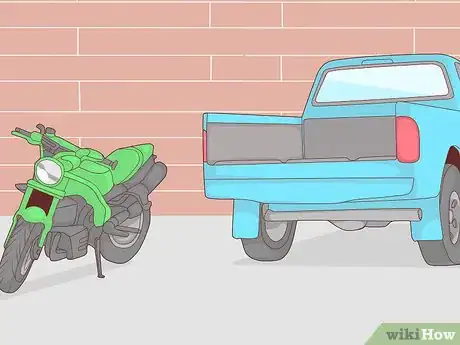
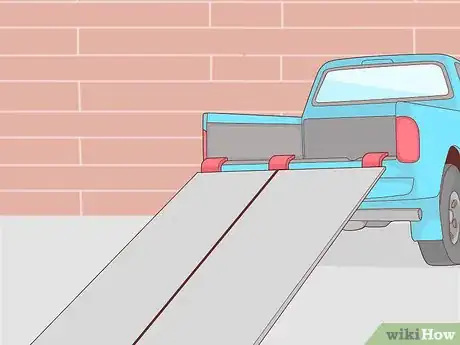
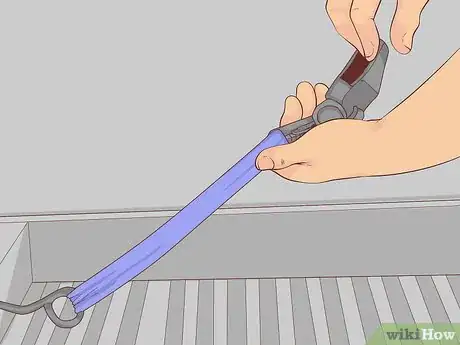
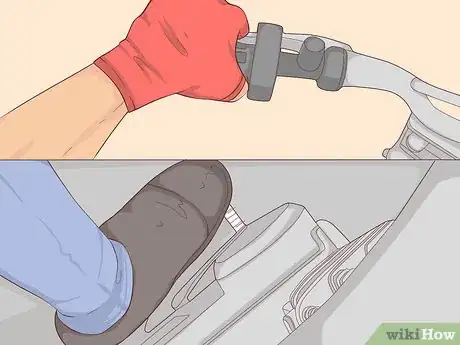



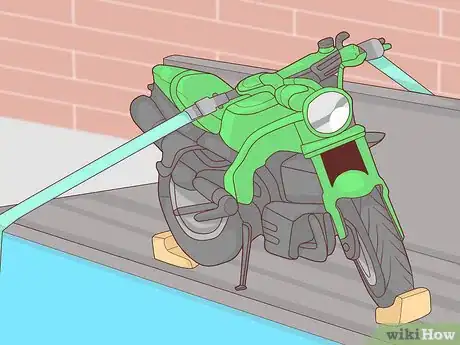
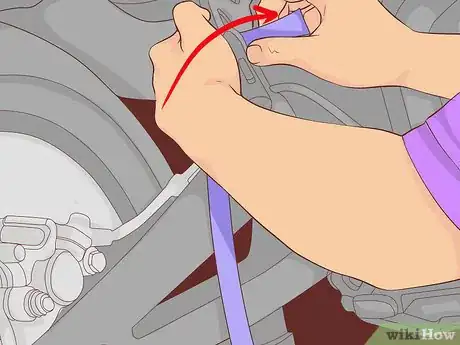





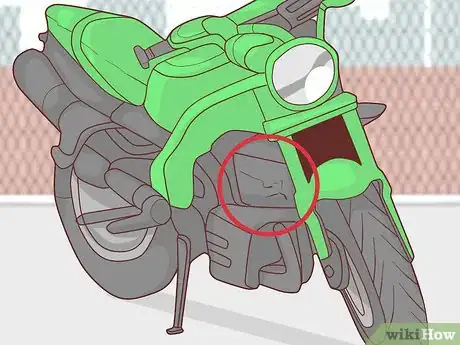


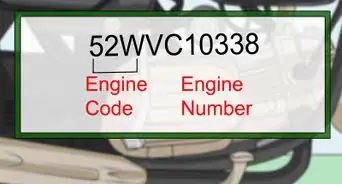
-Step-13.webp)
